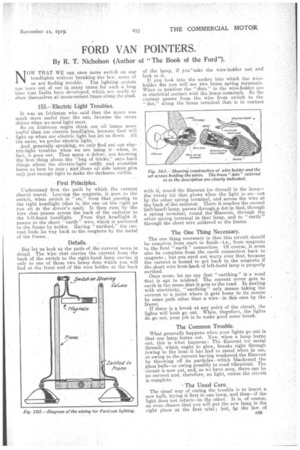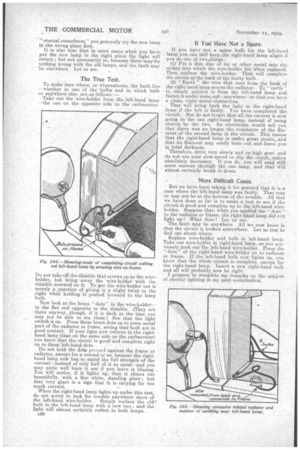FORD VAN POINTERS.
Page 25

Page 26

If you've noticed an error in this article please click here to report it so we can fix it.
By R. T. Nicholson (Author' of "The Book of the Ford").
NOW THAT WE can once more switch on our headlights without breaking the law, some of us are finding trouble. , The lighting systebi has been out of use in many cases for such a long -time that faults have developed, which are ready to show themselves at inconvenient times along the road.
153.—Electric Light Troubles.
It was an Irishman who said that the moon was much More useful than the sun, because the mown shines when we need light most.
So an Irishman might think our oil lamps more useful than our electric headlights, because they will . light up when our electric light has let us down. All the same, we prefer electric light.. And, generally speaking, we only find out our electric-light troubles when we are using it-----when, in fact, it goes out. Then many a driver, not knowing the first thing about the " bag of tricks," says hard things about the electric-light outfit, and stumbles home as best he may ; and those oil side lamps give only just enough light to make the darkness visible.
First Principles.
Understand first the path by which the current should travel. Leaving the magneto, it goes to thd switch, when switch is "on," from that passing to the right headlight (that is, the one on the right as you sit in the driver's seat). It then runs by the wire that passes across the back of the radiator to the left-hand headlight. From that headlight it passes to the short "earth" " wire, which is anchored to the frame by 'solder. Having "earthed," the current finds its way back to the magneto by the metal of the frame.
Details.
But let us look at the path. of the current. more in detail. The -wire that carries the current from the back of the switch to the right-hand lamp carries it only to .one of those two brass dots which you. will find at the front end of the wire holder at the back of the lamp, if you Lake the wire-holder out and look at it.
If you look into the socket into which the wireholder fits you will see two brass spring terminals. When in position the " dots" in the wire-holder are in electrical contact with the brass terminals. So the current passes from the -wire from switch to the "dot," along the brass terminal •that-is in contact
-with i, round the filament (or thread) in the lamp— the twisty bit that glows when the 'light is on—out by the other spring terminal, and across the wire at the back of the radiater. There it reaches the second (left-hand) lamp, passes through.a dot in that, through a spring terminal, round the filament, through the other spring terminal in that lamp, and to "earth" through the short wire soldered to the frame.
The One Thing Necessary.
The one thing necessary is that this circuit should be complete from start to finish—i.e., from magneto to the final "earth'' connection. Of course, it "nun also be complete, from the earth connection back to • magneto.; but you need not worry over that, because the current is bound to get back to the magneto if the short wire from back of left-hand lamp is properly earthed.
Once more, let me say that "earthing" is a word that is apt to mislead. The current never gets to earth in the sense that it gets to the road. In dealing with electricity, "earthing" only means taking the current to a point where it gets home to its source by some path other than a wire—in this ease by the frame.
If there is a break at any point of the circuit, the lights will both go out. When, therefcee, the lights do go out, your job is to make good some break.
The Common Trouble.
What generally happens when your lights go out is that one lamp burns out: Now, when a lamp burns out, this is what. happens : The filament (or metal thread), which ought to glow, breaks right through (owingto the heat it has had to stand when in use, or owing to the current having weakened the filament by throwing off its particles—which blackened the glass bulb—or owing possibly to road vibration). The circuit is now cut, and, as we have seen, there can be no current and, therefore, no light, unless the circuit is complete.
The Usual Cure.
The usual way of curing the trouble is to insert a new bulb, trying it first in one lamp, and then—if the light does not return—in the other. It is, of course, an even chance that you will put the new lamp in the right place at the first trial; but, 43, the law_ of
"eternal cussedness," you generally try the new lamp in the wrong place first.
It is also true that in most cases when you have put the new lamp in the right place the light will return ; but not necessarily so, because there -maybe nothing wrong with the old lamps, and the fault may -lie elsewhere. Let us see.
The True Test.
To make sure where, or whereabouts, the fault lies --whether in one of the bulbs and in which bulb or anywhere else, at, as -follows :— Take out the 'wire-holder from the. left-hand lamp ---the one on the opposite 'side to the carburetter.
Fig. 104.—Showing mode of completing circuit cutting out left-hand lamp by pressing dots on frame.
Do not take off the thimble that screws on to the wireholder, but bring away the wire-holder with the thimble screwed on it. To get the wire-holder out is merely a question of giving it a slight twist to the right while holding it pushed forward to the lamp bulb.
Now look at the brass "dots" in the 'wire-holder--in the flat end opposite to the thimble. (They are there anyway, --though, if it is dark at the time you may not be able to see them.) See that the light switch is on. Press those brass dots on to some metal part of the radiator or frame, seeing that-both are in good contact. If your light now returns in the righthand lamp (that on the same side as the carburetter) you know that the circuit is good and complete right up to those left-hand dots.
Do not hold the dots pressed against the frame cr radiator, except for a second or so, because the righthand lamp now has to stahd the full strength of the current—instead of only half of it as usual—and you may quite well burn it out if you leaVe it blazing. You will notice, if it lights up, that it shines out beautifully, with a fine white, dazzling glare ; but that very glare is a sign that it is earying far too much current.
When the right-hand lamp lights up under this test, do not worry to look for trouble anywhere short of the left-hand wire-holder. Simply replace the old bulb in the left-hand lamp with a new one ; and the light will almost certainly return in both lamps.
c50
If You Have Not a Spare.
If you have not a spare bulb for the left-hand. lamp you can still keep he right-hand lamp alight if you do one of two.things : (1) Put a thin disc of tin or other metal into the socket into which the, wire-holder fits when replaced. Then replace the wire-holder. That will complete the cireuitatthe back of the faulty bulb.
(2) " Earth ". the wire that runs -from the back of the right-hand lamp across the radiator. To " earth " it simply unhitch it from the left-hand lamp and fasten it under softie nut—anywhere—so that you have a clean, tight metal ',Connection.
That will bring back the light in the right:hand lamp if the left is faulty. You have completed the circuit. But do not forget that all the current is now going to the one right-hand lamp, instead Of being shared by the two. An electrician would tell you that there was no longer the resistance of the filament of the second lamp in the circuit. This means that the right-hand lamp is wider great strain,„ and that its filament may easily burn out and leave you iq total darkness. Therefore, drive very slowly and o hi ngh gear, and do not use your slow-speed or slip the clutch, unless absolutely necessary. If you do, you will send still more current through the one lamp, and that Will althost certainly break it down.
More Difficult Cases.
itit we have been taking it for granted that it is a case where the left-hand lamp was faulty. That may or may not be at the bottom of the trouble. All that we have done so far is to make a test to see if the circuit is good and complete up to the left-hand wireholder. Suppose that, when you applied the " dots " to the radiator or frame, the right-hand lamp did eot light up 1 What then '1 Let it see. The fault may be anywhere. All we now know is that -the circuit is broken somewhere. Let us test to find out about .where.
Replace wire-holder and bulb in left-hand -lamp. Take out wire-holder in right-hand lamp, as you previously took out fhe left-hand wire-holder. Press the dots of the right-hind-wire-holder on to radiator or frame. If the left-hand bulb now lights up, you know that -the whole circuit is complete, except for the right-hand lamp. Insert a new right-hand bulb and all will probably now be right. propose to complete my remarks on the subject of electric lighting in my next contribution.




























